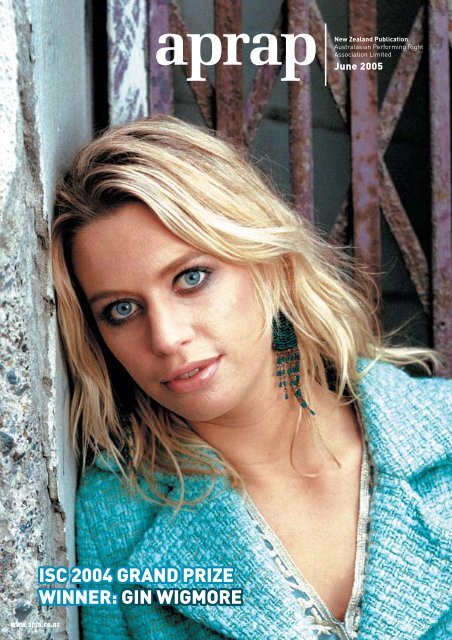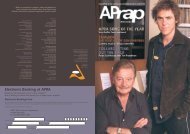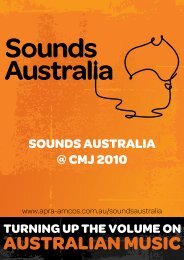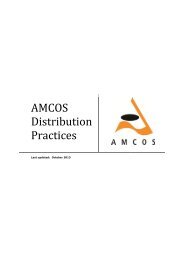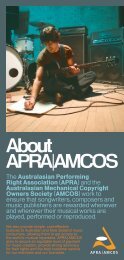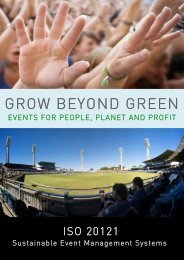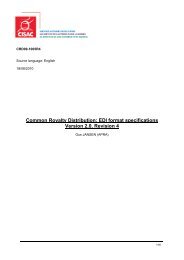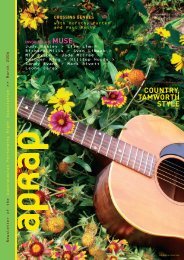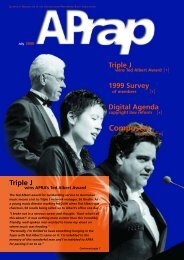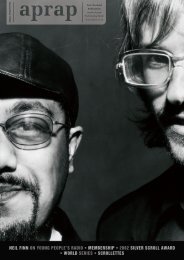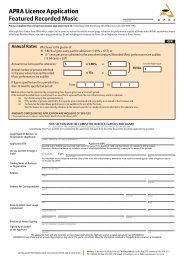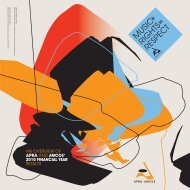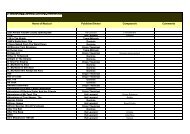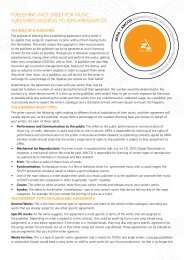Create successful ePaper yourself
Turn your PDF publications into a flip-book with our unique Google optimized e-Paper software.
aprap<br />
<strong>June</strong><br />
New Zealand Publication<br />
Australasian Performing Right<br />
Association Limited<br />
2005<br />
ISC 2004 GRAND PRIZE<br />
WINNER: GIN WIGMORE
A WORD FROM ANT<br />
The Gold Guitar Awards, the NZ Country Music Awards and the<br />
MLT Songwriters Awards – they all happen in the traditional home<br />
of country music, Gore. The weather was cold but the welcome<br />
could not have been warmer and the music<br />
was excellent. We were there, Arthur<br />
Baysting and I, together with Mahinarangi<br />
Tocker and Australian country singer Dianna<br />
Corcoran, for the aptly named Freeze Ya Bits<br />
Off busking competition, the songwriting<br />
seminars and workshops, the school visits<br />
and all the Awards. Congratulations to Kylie<br />
Harris for winning the inaugural APRA<br />
Country Music Song of the Year Award for<br />
her song “Give Me Something to Go On”<br />
and the Tui for Best Country Music Album<br />
for her album Kylie Harris. Also congratulations to Aaron Jury for<br />
winning the Mataura Licensing Trust Songwriters Awards for his<br />
song “Wyre Street”.<br />
Interest this year in NZ music month was bigger than ever. Major<br />
(L TO R): CATH ANDERSEN, ANT HEALEY, PM HELEN CLARK, JUDITH<br />
TIZARD, RICHARD THORNE AT THE MUSIC MONTH LAUNCH.<br />
corporates, sponsors, the media, politicians and most importantly<br />
the public all getting in behind NZ music. As a celebration of NZ<br />
music, music month in May is far from a washed up idea. The<br />
8,000 people at the Shihad launch<br />
concert, the 5,000 that bought NZMM<br />
T-shirts at Hallensteins or the many<br />
PHOTO: JASON HAILES<br />
thousands that listened to, watched or rocked<br />
to the many music month events certainly<br />
didn’t need convincing. Check out the photos<br />
on pages 8 and 9. Well done to all those that<br />
helped out in all the events up and down<br />
the country.<br />
There is a feast of information and<br />
inspiration for young and old inside <strong>APRAP</strong>.<br />
We feature young composer Gin Wigmore<br />
and the not so young but equally amazing composer, Willow Macky.<br />
We also mark the passing of three influential APRA members<br />
with tributes from their family and friends, on page 15.<br />
Anthony Healey Director of NZ Operations<br />
1 THE MAGNIFICENT “HANDS OF FAME”<br />
GOLD GUITAR MONUMENT WAS<br />
OFFICIALLY OPENED AT THE START OF<br />
GORE’S COUNTRY MUSIC FESTIVAL<br />
2 AARON JURY 3 THE BLIND STONED<br />
COWBOY, A PREVIOUS WINNER OF THE<br />
GORE FREEZE YA BITS OFF BUSKING<br />
COMPETITION, PERFORMS IN THE MAIN<br />
STREET WITH HIS DOG RINGO. IT HAILED<br />
DURING THE CONTEST AND THE NEXT<br />
DAY IT SNOWED 4 GOLD GUITAR<br />
GUESTS MAHINARANGI TOCKER AND<br />
DIANNA CORCORAN PERFORM WITH<br />
BEN SHEA (CENTRE) AT HERIOT<br />
PRIMARY SCHOOL. 1<br />
2<br />
4 3<br />
PHOTOS: 1, 3 ,4 ARTHUR BAYSTING<br />
The Silver Scroll<br />
Awards 2005<br />
Auckland Town Hall - September 12<br />
1975<br />
1965 1985<br />
4 decades of happy times at the Scrolls<br />
1995<br />
<strong>APRAP</strong> <strong>June</strong> 2005<br />
CONTENTS<br />
ISC 2004 Grand Prize Winner: Gin Wigmore........................................3<br />
Member Services..................................................................................4<br />
From The Heart ....................................................................................6<br />
Tuwhare................................................................................................6<br />
Music Month.........................................................................................8<br />
Tessarose...........................................................................................10<br />
Willow Macky......................................................................................10<br />
Chris Chetland....................................................................................11<br />
Australian News..................................................................................12<br />
SOUNZ...............................................................................................13<br />
Pasifika Festival ..................................................................................14<br />
Phil Fuemana, Karlos Quarter, Paul Hester.........................................15<br />
2<br />
COVER PHOTO: GIN WIGMORE PHOTOGRAPHED BY SPID
ISC 2004 GRAND PRIZE WINNER: GIN WIGMORE<br />
Virginia (‘Gin’) Wigmore’s astonishing win at the 2004 International<br />
Songwriting Competition (ISC) shows the value of taking your chances when<br />
opportunities beckon.<br />
Gin heard about the ISC through her sister, (who discovered it through NZ<br />
arts website ‘The Big Idea’). Rikki Morris, who’d produced and recorded Gin’s<br />
demos, told her “it’s a long-shot, but you’ve got to be in to win.”<br />
Never has a truer been word been<br />
spoken. The 18 year-old beat over 11,000<br />
entrants from 77 countries to take the ISC<br />
Overall Grand Prize for her song<br />
“Hallelujah”, receiving $40,000 (US) in<br />
prizes. Gin also won the Teen Category<br />
with her song “Angelfire”‚ and in July she’s<br />
off to Boston to attend Berklee College<br />
of Music’s Summer Performance Program.<br />
When she received a call from the ISC<br />
judges, director Candace Avery slyly first<br />
advised her of her Teen category win. “I<br />
had seen other New Zealanders on the<br />
list of finalists and hoped a New Zealander<br />
would win the Grand Prize, so I asked if<br />
they could tell me who’d won. Candace<br />
started talking to the other judges in the<br />
room – they had me on speaker-phone –<br />
I heard her saying ‘shall we tell her?’ and<br />
Macy Gray laughing while everyone told<br />
her to shut up. Then they told me I was<br />
the Grand Prize winner!”<br />
It’s a big accolade for one who was<br />
unsure about devoting herself to a musical<br />
career. In fact, her ISC Teen Category<br />
winner “Angelfire” was the first song she’d<br />
written, at the age of 14. She was<br />
performing at open mic nights at The<br />
Temple in Auckland while still attending Takapuna College – Finn Andrews from<br />
The Vines was there at the same time. Around then Gin did her first recordings<br />
with another Devonport local Rikki Morris. She had $150 to put 12 songs down<br />
“to get them out of my system”, but Rikki was convinced Gin was a natural.<br />
Describing herself as “dabbling in about<br />
a million things” Gin went to Argentina for<br />
her final year of high school, had a stint<br />
working as PR assistant for Universal<br />
Records on her return and then pursued<br />
a BA at Victoria University. However the<br />
biggest challenge to her songwriting was<br />
the death of her father; Gin didn’t write<br />
for a year afterwards. When she did write again, she produced “Hallelujah”<br />
about her relationship with her Dad.<br />
Writing has continued to be a personal, solo affair: “I always write in a quiet<br />
place. The bathroom has got great acoustics, it’s the best place to write and<br />
sing. We’ve got a tiny bathroom, an ensuite. I trundle my little stool in and sit<br />
in front of the shower with my guitar and play. Friends come over and find me<br />
in the bathroom with music spread everywhere round the sink and the shower!”<br />
“We’re amazed at the consistently<br />
high level of song-writing coming out<br />
of New Zealand in the last few years.”<br />
- Candace Avery, ISC director.<br />
This domestic method recalls the practice of one of her favourite artists, David<br />
Gray, who she admires for his “down to earth” quality: “He writes really nice<br />
songs, keeps things simple. White Ladder was recorded in his bedroom - that<br />
shows how simple it can get.”<br />
By the time she entered the ISC last year, Gin was studying to become a high<br />
school teacher at AUT. Not surprisingly, the win changed her plans: “now I’ve<br />
won this award I want this to be my thing.<br />
It’s given me the opportunity, the push,<br />
to do it. Being a songwriter is such a hard<br />
road, you’ve got to dedicate all your time<br />
to it. You’ve got to surround yourself with<br />
people who have faith in your work. The<br />
ISC has done that for me in a big way.”<br />
Gin is building up her support network.<br />
When she flies to the US she’ll also be<br />
meeting with music industry figures in<br />
Nashville, New York and London: “I am a<br />
bit wary of America, of the pressures. That<br />
they’ll see me as a dollar sign. But my<br />
mum is coming to Nashville with me. She’s<br />
a business-minded woman, and calls a<br />
spade a spade. So it’ll be good to have<br />
her there.”<br />
In the press release announcing the ISC<br />
results, Candace Avery drew attention to<br />
New Zealand’s musical success:<br />
“Songwriters from 77 countries<br />
participated in the 2004 competition, and<br />
remarkably, New Zealand had winners in<br />
four out of 16 categories. We’re amazed<br />
at the consistently high level of songwriting<br />
coming out of New Zealand in the<br />
last few years.”*<br />
Gin is insistent that NZ should be<br />
listening to Avery: “The help I got from the NZ music industry was bugger-all.<br />
Rikki Morris and I tried to get funding from Creative NZ - $2000 to do demos.<br />
We tried with NZ On Air. Instead Rikki did the recordings out of the goodness<br />
of his own heart. So many musicians struggle, and give up because they need<br />
to pay their bills… We need more showcase<br />
PHOTO: SPID<br />
nights, more open mic nights, more scouts<br />
out there. We need venues that are not<br />
being ripped down and made into carparks<br />
or apartment blocks… Now I’m more<br />
inclined to take it overseas.”<br />
Whether she stays offshore or not, it’s<br />
clear Gin has ties that’ll keep her returning:<br />
“I’d like to repay Rikki for all his help and do an album with him one day. There’s<br />
still this view that nothing can be done as well in NZ as in the US or UK. It’d be<br />
good if musos had the power to say ‘I want to do it here, come over here’.”<br />
* All NZ finalists received placings or honourable mentions: Ruia Aperahama;<br />
David Dallas, Malo Luafutu, Demetrius Savelio and Pete Wadams; Opetaia<br />
Foa’i and Malcolm Smith; Derek Soloman.<br />
Catherine Langabeer<br />
<strong>APRAP</strong> <strong>June</strong> 2005<br />
3
<strong>APRAP</strong> <strong>June</strong> 2005<br />
MEMBERSERVICES<br />
SILVER SCROLL AWARDS<br />
12 September 2005, Auckland Town Hall<br />
Entries: A unique feature of our awards is that members<br />
submit their own entries. All elected members of APRA are<br />
able to enter their own songs/compositions for the Silver Scroll<br />
Award, the Sounz Contemporary Award and the APRA Maioha<br />
Award. Entry forms for each of these awards are enclosed in<br />
this edition of <strong>APRAP</strong>. Check the entry conditions and due<br />
dates carefully.<br />
Invites: On average we host 400 people at our Silver Scroll<br />
Awards evening, with the majority of guests being APRA<br />
members. As we have considerably more members than seats,<br />
our invitation system is based on royalty earnings. In recent<br />
years, member invitations were extended to the top 800-900<br />
earners from the previous 12 months and RSVPs accepted on<br />
a ‘first come first serve’ basis. If you have been invited as a<br />
member – your invitation will be posted to you several weeks<br />
before the awards night.<br />
If you have any questions about the awards, please contact<br />
Petrina George.<br />
APRA PROFESSIONAL<br />
DEVELOPMENT AWARD<br />
APRA NZ is to administer a Professional Development Award<br />
for NZ members this year, independent from the Australian<br />
program. A single award will be presented to the writer selected<br />
as the winner. This award provides financial assistance for the<br />
recipient to develop his/her composing and song writing career,<br />
which could involve attending overseas music education courses,<br />
song writing workshops, composer seminars, or other relevant<br />
opportunities.<br />
We will provide further information and call for written<br />
submissions from members in August, with submissions due<br />
in October. Information and updates will also be provided on<br />
the APRA NZ website.<br />
See page 12 for a story from Mia Dyson – 2004 PDA recipient<br />
in the Australian program.<br />
AMCOS WRITER MEMBERSHIP<br />
Previously only music publishers were AMCOS members, but<br />
AMCOS has now extended its membership to include individual<br />
writers. If you become an AMCOS member, you will allow<br />
AMCOS to administer your mechanical rights in New Zealand<br />
and throughout the world, which includes the distribution of<br />
mechanical royalties. The three main areas AMCOS administers<br />
on behalf of its members are:<br />
1. Mechanical rights (eg music reproduced to CDs)<br />
2. Online/Digital/Ringtones<br />
3. Synchronisation/Reproductions into film, TV, DVDs and<br />
advertisements<br />
Upcoming Due Dates<br />
For Your Diary<br />
31 July: Live Performance Returns<br />
31 July: Jingle Reporting Forms<br />
31 August: Electronic local Live Performance<br />
Returns (Members Login Facility)<br />
14 October: ASCAP International Awards<br />
Programme<br />
Other examples of reproductions of music include Caller Tunes,<br />
and music videos broadcast on programmes such as Top of the<br />
Pops and Coke Countdown. On the application form you specify<br />
the sources that AMCOS will license and collect royalties<br />
for you.<br />
If your works are being reproduced, and you are not<br />
represented by a music publisher, you should consider becoming<br />
a writer member of AMCOS. Please contact us for the AMCOS<br />
Writer membership information and application form.<br />
APRA MUSIC GRANTS<br />
A 2004 grants recipient was Waikato Institute of Technology –<br />
APRA sponsored their award for Excellence in Composition in<br />
their Commercial Music programme. Winning student David<br />
Baxter was presented with<br />
this award at the School of<br />
Media Arts’ Special Awards<br />
Ceremony. Having been<br />
involved with this award<br />
for a few years APRA<br />
acknowledges the work by<br />
the music students and<br />
their tutors and hopes the<br />
award encourages a<br />
songwriter or composer to<br />
develop their music career.<br />
EXCELLENCE IN COMPOSITION AWARD WINNER<br />
DAVID BAXTER (LEFT) AND SIMON WELLS,<br />
COMMERCIAL MUSIC TUTOR<br />
<strong>WEB</strong>SITE UPGRADE<br />
Check out the Australian APRA website www.apra.com.au as<br />
it has a brand new look and new features for members. The<br />
APRA NZ website will also undergo an upgrade this year. If<br />
you would like to provide any feedback regarding improvements<br />
to the site – please forward your comments to Catherine<br />
Langabeer: clangabeer@apra.com.au<br />
ROYALTY PAYMENT UPDATE<br />
Earlier payments: Our local APRA royalty distributions are<br />
occurring earlier – with payments coming through in May and<br />
November, rather than in <strong>June</strong> and December. This is going to<br />
be the permanent timetable – so please make a note of this. If<br />
your contact details or bank account details change, we generally<br />
need the new details several weeks prior to a distribution. To<br />
be safe, always contact us straight away if any of your details<br />
change.<br />
Electronic royalty statements: Initiated by member feedback,<br />
electronic royalty statements were provided in the May 2005<br />
distribution for the first time. If you have an email address on<br />
file with us then you will automatically be provided with<br />
electronic statements, and advised by email that a payment is<br />
to be made. Electronic royalty statements can be accessed<br />
through the Members’ Login Facility and will remain on file<br />
for future access. If you would like to receive electronic royalty<br />
statements – please ensure we have your correct email address<br />
on file.<br />
MEMBERS’ LOGIN FACILITY<br />
If you need help with the Members’ Login Facility – to register<br />
works or submit live returns – contact Rita Luck or Petrina<br />
George for assistance. We have also created a step by step guide<br />
– let us know if you’d like a guide<br />
posted to you. This facility is<br />
continuing to be improved,<br />
including new features such as<br />
electronic royalty statements.<br />
This is an easy and convenient way<br />
to keep up to date with APRA.<br />
DAN TIPPETT<br />
4
PERFORMING LIVE? REPORTING<br />
TO APRA?<br />
We are aware that many members are not completing Live Performance<br />
Returns (LPRs). If you perform your own compositions live in public<br />
and you don’t submit a live return – you are missing out on royalties.<br />
What you need to know about LPRs:<br />
•You can submit paper returns – due 31 July each year; or submit<br />
electronic live returns via our Members Login Facility – due 31<br />
August each year.<br />
• Local LPRs are completed for the APRA year of 1 July to 30 <strong>June</strong>.<br />
• Royalties from LPRs submitted by the due dates will be paid in the<br />
November royalty distribution.<br />
• The main criteria for performances are that they are public – i.e.<br />
at a public place and open to the public. Private performances,<br />
such as weddings or birthdays, cannot be reported.<br />
•You can submit LPRs throughout the year, or a single LPR for the<br />
year – it is up to you.<br />
• If you forget to submit a LPR for one or more years, you can complete<br />
a backdated return – contact Rita Luck or Petrina George to confirm<br />
this procedure.<br />
• For overseas performances (outside NZ, Australia and the Pacific),<br />
you need to submit an Overseas Live Performance Return – these<br />
are due immediately after the performances.<br />
To complete a Live Performance Return, you need the<br />
following details:<br />
1) The dates of your performances.<br />
2) The details of where you performed – venue names and address<br />
details.<br />
3) A list of the works performed, including titles, writer details and<br />
number of performances.<br />
What about set lists? Set lists are needed when you perform at<br />
concerts, festivals or events that are licensed as a promoted<br />
performance by APRA and these are required straight after the<br />
performance. Examples of such events are the Big Day Out,<br />
international artist supports, and University Orientation gigs. The<br />
promoter or event organiser should ask for your set list, but you<br />
should also copy your set list to APRA. These performances should<br />
not be reported on Live Performance Returns.<br />
Regardless of the nature of the performance, please report the<br />
details to us. If you are unsure what to do or if you need help, please<br />
contact Member Services.<br />
The awards were a fantastic celebration and the committee is<br />
beginning preparations for the 2006 event. If you have any questions<br />
about these awards, including eligibility for entries, please contact<br />
Petrina George (member of the Pacific Music Awards Committee).<br />
2 3<br />
1<br />
4<br />
PHOTOS: JASON HAILES<br />
PACIFIC MUSIC AWARDS<br />
Celebrating Pacific Music<br />
Congratulations to the APRA members who won awards at the<br />
inaugural Pacific Music Awards, held on 11 March. Opened by Prime<br />
Minister Helen Clark, 7 music awards were presented, including 6<br />
new Pacific Music Awards, and the New Zealand Music Award (Tui)<br />
for Best Pacific Island Album. The awards were organised by the<br />
Pacific Music Awards Committee, in partnership with RIANZ and<br />
were supported by a number of organisations, including APRA.<br />
Adding to the prestige of the awards were the beautiful new Pacific<br />
Music awards. Designed by Colin Falefata, they literally shone on<br />
the night.<br />
The Pacific Music Awards Committee hopes the awards will raise<br />
the profile of Pacific artists and Pacific music to the wider community,<br />
and also inspire young artists and writers.<br />
The results from the Pacific Music Awards are:<br />
• Lifetime Achievement Award: Phil Fuemana<br />
• APRA Best Pacific Song: Kas Futialo and Ian Seumanu for “Su’amalie”<br />
• Niu FM Best Pacific Music Album: Ardijah for Journey<br />
• C4 Best Pacific Female Artist: Sara-Jane Auva’a for “Sara-Jane”<br />
• New Zealand Music Industry Commission Best Pacific Male Artist:<br />
Tha Feelstyle for “Break it to Pieces”<br />
• Radio 531PI Best Pacific Group: Adeaze for “Always & For Real”<br />
• Niu FM Best Pacific Hip Hop Artist: Tha Feelstyle for “Break it<br />
to Pieces”<br />
5 6<br />
1 (L TO R) TONY FUEMANA, BROTHA D, CHRISTINA FUEMANA, REV. MUA<br />
STRICKSON-PUA, PM HELEN CLARK 2-3 KAS FUTIALO (THA FEELSTYLE)<br />
4 ADEAZE 5 SARA-JANE AUVA’A 6 ARDIJAH<br />
Member Services Contact Details:<br />
Petrina George (Manager – Member Services) Ph: (09) 379 0638 or<br />
0800 69 2772 ext 209, Email: pgeorge@apra.com.au<br />
Rita Luck (Member Services and Distribution) Ph: (09) 379 0638 or<br />
0800 69 2772 ext 207, Email: rluck@apra.com.au<br />
Catherine Langabeer (Communications and Events) Ph: (09) 379 0638<br />
or 0800 69 2772 ext 210, Email: clangabeer@apra.com.au<br />
Member Services email: nz@apra.com.au<br />
<strong>APRAP</strong> <strong>June</strong> 2005<br />
5
Ask Lisa Nimmo and Shelley Hirini from<br />
‘Pearl’ how they met and their answer will<br />
surprise you: “we were both seeing the same<br />
shrink!” For these sassy Wellington<br />
songwriters, their unexpected meeting has<br />
dramatically changed the course of their<br />
lives. For this edition of ‘From the Heart’<br />
we have asked them to share their journey<br />
so far with us.<br />
Geoff Maddock (Goldenhorse)<br />
Charlotte Yates was surprised by Geoff’s choice of ‘O Africa’. She explains<br />
this was: “partly because of its brevity – it’s the shortest poem on the<br />
album – and partly because of its utter bleakness. Co-writer Kirsten<br />
Morrell also apparently had some qualms initially, but the resulting<br />
track is evidence enough. That’s how the process works really – if the<br />
composers feel a good match with the poem, then the setting will reflect<br />
them and their sound authentically.”<br />
Says Geoff: “I had one book of poetry by Hone Tuwhare, called No<br />
Ordinary Sun. It was a book of his early poems, all published in the ‘60s,<br />
and ‘O Africa’ just leapt straight out at me. One of the most appealing<br />
things about it was its brevity, just 9 lines. Great. The next was the<br />
imagery, simple and vivid, with dark reds and blacks. I realised that it<br />
would sing well, and I liked it.<br />
“I love using someone else’s lyrics, it means I don’t have to write any<br />
and have to come up with themes and images that just bleed me!<br />
Working on ‘O Africa’ was very freeing, it made me realise I could profit<br />
from a different songwriting process, where I come up with the words<br />
all first and don’t let myself deal with the music until the words are as<br />
finished as they can be.”<br />
“Some might say we left our run a little<br />
late – it took us until our 30’s to muster<br />
up the courage and belief in ourselves to<br />
pursue the careers we have secretly always<br />
wanted – to entertain people with our music.<br />
At the time we were individually seeing a<br />
life coach who, after identifying that we<br />
both had a passion for music, suggested<br />
that we hook up. And the rest is history.<br />
We formed ‘Pearl’ at the beginning of 2003<br />
and Wellington musician Chris Jones joined<br />
us shortly after to complete the trio.<br />
With all three of us being songwriters and<br />
with a few years of life experience to<br />
write about, there is never a shortage of<br />
new material to work with. Our sound is<br />
based on the fusion of two lead female<br />
vocals and produced to reflect who we truly<br />
are – people who have faced enough of life’s<br />
challenges to know that each one of them<br />
makes you better and stronger. The result<br />
is reflective moody verses wrapped in hooky,<br />
driving uplifting choruses.<br />
<strong>APRAP</strong> <strong>June</strong> 2005<br />
Our songs have been described as<br />
sophisticated, fun and laced with optimism,<br />
a bit like us really!!”<br />
Pearl’s debut single “Fallacy”, is evidence<br />
of their fresh approach to the pop genre.<br />
You can currently download “Fallacy” free<br />
from their website www.pearlband.com<br />
Their debut album is planned for release<br />
in December this year.<br />
Whirimako Black<br />
Whirimako was working with New York-born, Aucklandbased<br />
composer and pianist Jonathan Besser – “exploring<br />
my tones, notes and range with a good pianist” – when she<br />
started on her song for Tuwhare: “I picked a poem – ‘Spring<br />
Song’ – and I’d started a piece of music. I knew the man<br />
with the chords was the man who played the grand piano<br />
so I asked Jonathan to compose with me.”<br />
“As I went through the poem with Jonathan I sensed<br />
something awful had happened to Tuwhare in spring. It was<br />
a very dark moment for him but felt I could express it and<br />
would try and resolve it in my tones as well. It starts quiet<br />
and gentle and works its way up till it’s full and gets its<br />
‘internals’ out. I also couldn’t help myself but translate the<br />
poem’s title into Maori, and open the song that way.”<br />
6
PHOTO: ROBERT CATTO/WWW.CATTO.CO.NZ<br />
Mina Ripia (WAI)<br />
“We originally wanted ‘Rain’, because our group<br />
name is WAI, but Don McGlashan had already chosen<br />
it. I’d never heard of Tuwhare until Charlotte gave<br />
us this opportunity. It was a challenge because it<br />
was in te reo Pakeha and we had to make English<br />
words sound WAI-styley… We spent a lot of time<br />
working on the poem ‘On a theme by Hone Taiapa’,<br />
breaking down each line. I would give my whakaaro<br />
and Maaka would give his interpretation. It’s a carver<br />
asking a poet: “what do you do with your waste<br />
words?” Like the music you don’t use as a musician<br />
– it was related to our journey.”<br />
MINA PERFORMING AT THE TUWHARE LAUNCH<br />
May saw the release of Tuwhare – an album of Hone Tuwhare’s poems<br />
made into songs. Charlotte Yates – who’d done the same thing with James<br />
K Baxter’s poems in 2000 – directed the Tuwhare project for Toi Maori<br />
Aotearoa. For Tuwhare, Charlotte wanted to capture both the diversity in<br />
Tuwhare’s work, and the diversity of sounds in NZ music:<br />
“All the artists involved have a pretty comprehensive recording and live<br />
performance background. I also looked at each artist’s previous work to get<br />
a feel for which type of poem they might select to highlight the breadth of<br />
Hone Tuwhare’s work – first published in 1964, Hone has produced some<br />
14 anthologies. The direction given was for each artist to select their own<br />
poem – there was pretty much a ‘first come first serve’ policy on selection.<br />
Hone was very generous about what we could do, there was a lovely lack of<br />
‘preciousness’ from him. Artists could use extracts or complete texts and<br />
had control over the production of their work with a proviso to liaise with<br />
me before a ‘sign off’.”<br />
Herself a contributor to the album, Charlotte was well aware of the unique<br />
challenges that “musical anthologies” like Tuwhare present: “in these<br />
projects, the words are standing in front of you: that’s a very different place<br />
to starting writing music from… I think the hardest part of this style of project<br />
for people is finding a poem that suits them.”<br />
Tuwhare artists will perform a number of concerts including at the NZ<br />
International Festival of the Arts in March 2006. Check www.charlotteyates.com<br />
for details.<br />
Charlotte Yates<br />
“I chose a poem called ‘Mad’ that I first found in Deep River<br />
Talk, a 1993 anthology. It is a compelling poem about someone<br />
waiting for their lover to arrive, describing the rush of feelings<br />
that that produces and shaking their head at it. I liked the<br />
images, the language and that I would sing it about a woman.<br />
I liked that the poem starts so calmly and ends in a right state,<br />
with a chuckle almost.”<br />
L TO R: CHARLOTTE YATES, WHIRIMAKO BLACK, MINA RIPIA, DEAN HAPETA DISCUSSING<br />
TUWHARE AT PAO!PAO!PAO!<br />
PHOTO: SOUNZ<br />
Dean Hapeta (Te Kupu)<br />
Dean’s choice of poem surprised Charlotte for the completely<br />
opposite reason to Geoff’s choice: it was 2 and half pages<br />
long! Dean was also the only artist who did absolutely<br />
everything on his own. He wrote, played (including the<br />
saxophone), produced and mixed it.<br />
“I first met Hone at the 2003 Wellington International<br />
Poetry Festival and I felt able to do it because I’d met him. I<br />
hadn’t read anything by him before that. I thought I would<br />
do something different, like a love poem, but in the end I<br />
came back to something more onto it for me. ‘Speak to me,<br />
brother’ is talking about war, about Maori, about wanting to<br />
have a deep discussion when discussions don’t usually get<br />
that deep. He was talking about Vietnam, but it’s still the<br />
same situation. I was five when the poem was written, but<br />
it’s still relevant. It fitted with me.”<br />
TE KUPU PERFORMING AT THE TUWHARE LAUNCH<br />
<strong>APRAP</strong> <strong>June</strong> 2005<br />
7<br />
PHOTO: ROBERT CATTO/WWW.CATTO.CO.NZ
1 2 3<br />
Music Month 2005 - with the Black poster and T-shirt - got off to a rocket-fuelled<br />
start with the live Shihad concert in Aotea Square. Despite the rain, around eight<br />
thousand rocked while Jon and co. tore up the stage. The concert, beautifully<br />
filmed and replayed on C4, was the best-possible start to the best ever<br />
Music Month.<br />
There was lots more television including TV2’s first ever Song Star, masterminded<br />
by Mike Chunn, where the public saw five unknown songwriters selected<br />
and their songs performed live and voted for on television. The winner was<br />
Lachlan Taingahue from Gisborne who’s track “I’ll keep on Rapping” was<br />
produced by Nate D from the Dawn Raid studios.<br />
Other highlights included the annual RBA NZ Music Showcase in Auckland,<br />
tours by the D4, the Fanatics, Katchafire, Goodnight Nurse, 48 May, Emerald and<br />
others and the Hallensteins T-shirts selling out nationwide.<br />
Steriogram played Parliament steps to bemused MPs while in Britain The<br />
Checks did the NME New Music tour and in LA Goldenhorse and Evermore<br />
appeared at heavyweight industry conference Musexpo.<br />
Chartwise, Fat Freddy’s and Savage topped the album and singles charts<br />
respectively and radio airplay was massive.<br />
There were also seminars, Pao!Pao!Pao! in Wellington, a youth music forum<br />
at Tai Poutini in Greymouth - including killer performances by local bands Puha<br />
and Kortion - and countless other locally-generated activities. We hope you got<br />
involved in some of them.<br />
6 7<br />
<strong>APRAP</strong> <strong>June</strong> 2005<br />
11 12<br />
8
4 5<br />
MUSIC MONTH<br />
PHOTOS: 1 – 9 AND MAIN PHOTO: JASON HAILES, 10: SOUNZ, 11: DEBBIE LITTLE, 12 – 13: POS MAVAEGA 14 – 16: ARTHUR BAYSTING, 17: REBEKA<br />
1-3 SHIHAD 4-9 THE RBA NZ MUSIC SHOWCASE: PLUTO; SJD; MCS CAMILLE GUZWELL AND MIKE PURU; ANIKA MOA; GRAMSCI; FRONTLINE 10 TONI HUATA AT PAO!PAO!PAO! 11 SONG STAR AND WINNER LACHLAN TAINGAHUE<br />
12-13 POLYPHUSION SHOWCASE ‘LIVE’ IN CHRISTCHURCH: THE BROFESSIONALS; TAOS 14-16 TAI POUTINI FORUM, GREYMOUTH: PUHA (14 – 15); KORTION 17 THE WAH SELECTAH LINE-UP IN AUCKLAND<br />
MAIN PHOTO THE NZ MUSIC MONTH LAUNCH CROWD<br />
8 9 10<br />
13 14 15 16 17<br />
<strong>APRAP</strong> <strong>June</strong> 2005<br />
9
Tessarose is a successful small business in the niche market of preschool<br />
children’s music. Co-owners Tessa Grigg and Brian Ringrose<br />
started with one album about 15 years ago and now have 18 Tessarose<br />
retail albums, 20 franchise albums and have collated several albums<br />
for other people. Sales are well over 250,000 units – that’s the equivalent<br />
of over 16 platinum albums in as many years!<br />
Incredibly, Tessarose is an entirely in-house production. Based in<br />
Christchurch, Brian and Tessa record the songs, manufacture, market<br />
and distribute the CDs in Australasia and beyond – including to<br />
Singapore, Hong Kong, Korea, Finland, Dubai, England and the USA.<br />
They compose many of their own songs (over 150 songs) and license<br />
the rest through AMCOS or direct: “Without the help and advice of<br />
APRA we would certainly have got into trouble<br />
over several legal matters – mainly through<br />
ignorance. In the early days we ended up making<br />
a visit to APRA in Auckland and from that point<br />
have enjoyed a great relationship.”<br />
Here Brian Ringrose shares some of their<br />
business experiences from along the way:<br />
“When our business first started we were full<br />
of good ideas and perceived ideas about how<br />
the market worked from my experience of 30<br />
travel and accommodation costs were around $1000 and we grossed<br />
something like $8000 – we then realised that people had to hear and<br />
see the music being used by the end user (the children and<br />
caregivers/teachers) to make up their mind to purchase. For that was<br />
the marketing dilemma: the end user – the child – was not the purchaser.<br />
We needed to get these adults to like the music so that they would buy<br />
for their children. We also quickly found that children’s music in<br />
general was not purchased through record shops but specialty<br />
education stores.<br />
“I was adamant that every CD/cassette we sold should have a very<br />
obvious name plate so that anybody who heard our music would know<br />
how to contact us. Every tape/CD is a business card. This has been the<br />
one substantial factor that has created our<br />
overseas sales and given us exposure to<br />
customers in places we have never heard of.<br />
We usually approach these customers as a lead<br />
to their area and away we go. In recent years<br />
we have spent quite a bit of our efforts directing<br />
people to our website. This has taken a while<br />
to catch on but is starting to show returns. Our<br />
trips to the USA and Australia usually give good<br />
net activity for some time after the visit.”<br />
odd years at that point in the pop and general<br />
Brian also attributes Tessarose’s success to<br />
(L TO R): BRIAN RINGROSE AND SAMUEL, COLIN THE KIWI, JEANNA<br />
music business.” (Brian was in The Invaders RODGERS AND CASSANDRA, TESSA GRIGG.<br />
their focus on making a quality product. Through<br />
with Ray Columbus, worked for 15 years as a<br />
Tessa Grigg’s background in early childhood<br />
session musician for TVNZ in Christchurch, wrote jingles for Radio education and her involvement with GymbaROO – an Australian-based<br />
Otago and has helped produce and record many young artists – including movement and music-based programme – Tessarose’s music is created<br />
Kylie Harris).<br />
specifically with children’s developmental needs in mind. This means<br />
“We found quite quickly that we have a very isolated market. In fact songs are simple, repetitive and slow enough to allow for the young<br />
we knew exactly how big it was – the Department of Statistics can tell listeners to understand and then respond to. They are also recorded<br />
you each year how many babies are born – add a few years and you at a higher pitch, as this is what children respond to best!<br />
know the size of the NZ market. We tried all sorts of marketing ideas: “We have focused on quality music from an arrangement,<br />
direct mail; magazine advertising; TV; radio; and live performance. We instrumentation and vocals point of view. We consider why we are<br />
joined Canterbury Business Grow and even had a mentor.<br />
making this music and what is it designed to achieve more than how<br />
“A big let-down for us was advertising in a major magazine. It cost much money can we make. If the product is good and you are having<br />
over $2000 and we got about 10 sales. We then organized to do some fun the funds take care of themselves.”<br />
live workshops for parents and children in Hamilton over 3 days. Our www.tessarose.co.nz<br />
Willow Macky<br />
<strong>APRAP</strong> <strong>June</strong> 2005<br />
10<br />
Now in her ’80s, Willow Macky is one of New Zealand’s great, but largely<br />
unheralded songwriters. It would be unusual to have attended an end of year<br />
school assembly in New Zealand in the last 40 years and not have sung her<br />
work “Te Harinui – A New Zealand Carol”. Of her prodigious output of over 113<br />
songs and 92 lyrics, Willow wrote mostly folk songs, even a folk opera called<br />
The Maori Flute.<br />
She is a strong exponent of writing about local experiences, history, people<br />
and places, including Maori legend and tradition. In fact the reason she started<br />
writing songs was because while she had collected many folksongs from<br />
around the world, she couldn’t find any about Auckland. This led to “Waitemata<br />
Harbour”, and later “Tamaki Moonlight”. Singing about her own city seems to<br />
have received a mixed reaction – in interview in 1994 she remembered people<br />
laughing when she sang the line “I love to go down to old Mission Bay” in<br />
“Tamaki Moonlight” because of the strangeness of hearing a local place<br />
mentioned in a ballad.<br />
One of Willow’s ‘breaks’ was meeting Swedish-American balladeer William<br />
Clauson on his visit to NZ in 1959. He was looking for local works, and recorded<br />
five of Willow’s songs, including one she wrote specially set to a melody he<br />
particularly liked – it was a tradition for each country he visited to supply<br />
different words to the same tune.<br />
The great bass singer Inia Te Wiata praised Willow’s songs as “the only New<br />
Zealand composer besides Alfred Hill who can capture the authentic Maori<br />
atmosphere.” Willow’s career spans the time when issues of cultural<br />
representation were coming to the fore. By 1990 she had revised her 1964<br />
composition “Waitangi Anthem”, because she found<br />
“as time went on I began to realise that the words<br />
of the anthem did not adequately reflect, in<br />
these changing times, the feelings of the<br />
Maori community about the Treaty.”<br />
Willow’s life and work are a valuable part<br />
of the story of New Zealand music. As Willow<br />
observed over 40 years ago “we have<br />
something to sing about – a land as<br />
beautiful, interesting and worthy as any<br />
other… we wish to pay [New Zealand]<br />
a tribute which is long overdue and<br />
give pleasure to our people and<br />
all others who wish to hear.”
<strong>APRAP</strong> talks to Chris Chetland about his work as head of Kog<br />
Transmissions and one half of breaks duo Baitercell and<br />
Schumacher.<br />
“We just wanted to play in the studio with bass”. A master of<br />
understatement, this is how Chris describes the formation of<br />
internationally successful Baitercell (Chetland) and Schumacher<br />
(Timmy Schumacher). Such understatement<br />
extends to Kog Transmission’s recent successes<br />
in the arena of ad production: “things fall into<br />
your lap to a certain extent.”<br />
Having been through a series of shifts in<br />
personnel and focus since its establishment in<br />
1997, Kog Transmissions now operates as a<br />
production facility. With Chris joined by John<br />
Chong-Nee, Dave Baxter, Dave Holmes (of Venn<br />
productions) and Mike Carpinter (promotion) it<br />
produces albums (recently Gramsci and<br />
Autozamm), masters recordings (including Savage<br />
and Tourettes), and produces music for<br />
advertisements and TV (such as Nokia Calimero<br />
(Asia), Guinness (Asia), Coke New Releases (TV<br />
2), Coast Theme (Maori TV) and Burger King).<br />
Chris’ production and mastering skills also mean<br />
that Kog informally serves as a training ground<br />
for new producers.<br />
Chris sees creative value in commercial composition work: “the<br />
good thing about doing an ad is that people come to you, and request<br />
reggae or hip hop, and you have to step out of your comfort zone<br />
and get a whole new style… commercial work gives you a lot more<br />
intellectual freedom, like learning a new language and ending up<br />
with a whole new vocabulary.”<br />
He also suggests that “in another sense you could say my<br />
commercial work is my art. Look at the KLF - the greatest band of<br />
all time. They’re art theorists who operate within the commercial<br />
world. Their book The Manual (how to have a number one the easy<br />
way) is the most important book about the music industry.”<br />
Commercial work as art, art as commercial work, Chris reveals<br />
“we used ‘the rules’ for “Lay It Down”, which got to #1 on the Alt<br />
Charts for last year. All done using their systems.” “Lay It Down”<br />
has also been released in the US by DJ Icey – America’s biggest<br />
breaks DJ.<br />
The KLF ‘systems’ involve “looking at basic structures. It’s just<br />
knowing what’s going on at a particular time, music-wise. You need<br />
to have good hooks or words that you can remember after one<br />
listening. Kylie, Spice Girls, Abba, Soundgarden had these hooks,<br />
these elements. Such music is just as much an art statement; you’re<br />
just approaching art in another way.” Hooks and words<br />
notwithstanding, Chris maintains that the “imperfections in the mix<br />
are the most important part.”<br />
But it requires a great deal of skill for imperfections to ‘work’.<br />
Chris asserts that to become a good producer “you must spend all<br />
your time, every waking moment that you can get away with on it.<br />
10 hours a day, 6 or 7 days a week. I question whether you could<br />
become a really good producer if you go into a commercial job. You<br />
are going to be constrained to do specific things.”<br />
Timmy Schumacher agrees about the value of the non-commercial<br />
and non-institutional path: “it’s like what David<br />
Mamet said about acting schools: they are institutions<br />
with a set of rules and a set of expectations about<br />
what you can turn out as.” Having trained in acting<br />
at South Seas, Timmy has “done institutions”: “they<br />
are good for young people – they’re there to inspire<br />
you. But I’m a big proponent of teaching yourself in<br />
a way you can understand. That’s the cool thing<br />
about production: you can buy a $3,000 PC and you’re<br />
there. DJ Ali has made beats on a PC with a<br />
SoundBlaster Sound Card – the shittiest sound card<br />
you can get, but it sounds great. The ethos is to do<br />
with how much work you put into it and where you’re<br />
coming from. My one year on Logic has been good,<br />
but my 14-15 years as a DJ is valuable experience<br />
as well.”<br />
Getting Logic down in one year is no mean feat,<br />
as Timmy explains: “Logic is translated from German.<br />
It’s like finding a needle in a haystack if you want to do one simple<br />
thing. Normally to learn Logic off the bat would take a couple of<br />
years – at least – to learn it as well as, say, Paddy from Pitch Black.<br />
But Chris is really well-versed in Logic. He has used the programme<br />
for many, many years and knows all the shortcuts and tricks. With<br />
Chris I learnt what I needed to in a year. He’s also got a really great<br />
way of describing things. For a person who’s an academic [Chris<br />
did a Masters in non Darwinian evolutionary theory] he’s able to<br />
strip things back to a laughably simple form of explanation.”<br />
In Chris’s opinion, being a producer is “all about working with<br />
people and taking things from them. You are as much a social<br />
worker/mum/dad/brother/sister as a producer. You need to be sure<br />
you can get the best from them. You need focus but also the ability<br />
to let go. Training others, Chris sees himself as a facilitator: “you’re<br />
looking at potentialities… they need to be working on their own stuff,<br />
they’ve got to create their own adventure.”<br />
Chris’s own next adventure is a trip to Australia, Europe and the<br />
US to work with some “big mastering engineers”, train up in “southern<br />
style hip hop, particularly crunk, and learn some tricks for RnB”. He’ll<br />
also be “shopping beats”, confident that between him, Timmy<br />
Schumacher, John Chong-Nee and Dave Baxter they have a broad<br />
range to offer. In terms of international export, he notes that “it<br />
depends what you are trying to export: artists, beats, or advertising.<br />
Different environments have different sets of rule to work in.”<br />
Fortunately, juggling different systems seems to be Chris’ specialty.<br />
www.kog.co.nz<br />
All member profiles by Catherine Langabeer<br />
<strong>APRAP</strong> <strong>June</strong> 2005<br />
11
AUSTRALIAN NEWS…<br />
US-AUSTRALIA FREE TRADE AGREEMENT (FTA)<br />
INCREASES COPYRIGHT DURATION<br />
From 1 January 2005, all musical works, lyrics and sound recordings<br />
that are still in copyright on 1 January 2005 will benefit from an<br />
extra 20 years protection in Australia. Therefore, the basic duration<br />
for copyright works is until 70 years after the end of the year in<br />
which the author died.<br />
For example, if a composer died in 1954, copyright<br />
on the works that were published during his or her<br />
life will expire on 31 December 2004. Under the Act<br />
there is no revival of copyright, so all works that fell<br />
into the public domain on 31 December 2004 will<br />
stay public domain.<br />
If the work has not been published during the<br />
lifetime of the author, the copyright protection applies<br />
for 70 years from the first publication or broadcast<br />
of the work. There are also different rules for works<br />
first published anonymously or pseudonymously or<br />
if it is made or first published by the government.<br />
A song comprises a musical work and a separate literary work<br />
(the lyrics). The duration of each component depends separately<br />
on the life of the composer and the lyricist. Where a work is written<br />
jointly, so that the contribution of each author cannot be separated<br />
from that of the other, the death of the last (known) surviving author<br />
is used to work out duration.<br />
There is also a separate copyright in the sound recording of a<br />
song, usually owned by a record company. Its duration is now 70<br />
years after first publication of the sound recording. It is indefinite<br />
if unpublished. Copyright in a sound recording first published in<br />
1954 will have become public domain on 31 December 2004 (the<br />
copyright in the underlying works on the record may still be<br />
protected). There is no revival; therefore the 70 year<br />
rule will only apply to sound recordings first published<br />
in 1955 onwards. Interestingly, the duration of<br />
copyright in sound recordings in the EU has remained<br />
at 50 years from publication.<br />
For print music, the separate copyright in the<br />
typographical arrangement, the “published edition”<br />
remains at 25 years after publication.<br />
All these rules apply on a national treatment basis.<br />
This means that works by authors from, or copyright<br />
materials first published in, countries that are<br />
signatories to the copyright conventions will benefit<br />
from the new rules of duration. The old rules of life<br />
plus 50 still apply in New Zealand and other APRA territories.<br />
There are significant benefits in harmonising the term of copyright<br />
protection with our major trading partners. Our rights will benefit<br />
from extended protection in those countries and it will help users<br />
here obtain clearances for use of copyright material internationally.<br />
A detailed information sheet (G23), is available from the Copyright<br />
Council’s website: www.copyright.org.au<br />
Scot Morris, Director of International Relations, APRA<br />
PHOTO: BRIDGET ELLIOT<br />
MIA DYSON: 2004 PROFESSIONAL DEVELOPMENT<br />
AWARD RECIPIENT<br />
<strong>APRAP</strong> <strong>June</strong> 2005<br />
12<br />
“I arrived in Toronto at dusk, in the middle of the northern summer<br />
of 2004, after six months planning for my first overseas ‘tour’. It<br />
was a jumble of ideas and possibilities until I found out in January<br />
2004 that APRA would support me with a Professional Development<br />
Award, making the trip an exciting reality.<br />
“I set out to play as many gigs as I could in the two weeks I was<br />
there. I’d already been invited to play at the North by North East<br />
music conference in Toronto and the Vancouver Island folk festival<br />
but I’d made a lot more contacts via musicians and the internet<br />
and so I performed at many open mic nights, supports for some<br />
Canadian artists and even at a recording session for a group of<br />
aspiring sound engineers. Through a chain of gigs that led me from<br />
an open mic night to a support for a wonderful Toronto-based folk<br />
singer to a rock gig at the El Macombo, I got to play on the same<br />
stage where Stevie Ray Vaughn had made his landmark Live at the<br />
El Macombo video many years earlier.<br />
“In July I headed to London and straight up the M1 to the<br />
Stockton Riverside festival, for my first experience of the English<br />
countryside – foggy, windy, rainy (mid summer). They were a<br />
couple of strange gigs and the locals didn’t know what to make of<br />
this Australian roots singer (they laughed at the word roots…)<br />
“The Edinburgh Festival had to be the most exciting part of the<br />
trip. I had two dates at the stunning Spiegeltent plus a few promo<br />
gigs on a huge open-air stage below the famous castle. The<br />
atmosphere was incredible and the audiences there seemed to<br />
embrace me more than in Stockton. I had a couple of showcase<br />
gigs in London between shows so I spent a lot of time driving up<br />
and down the M1. The showcase gigs did the job and I got to play<br />
in front of some of the labels I’d been interested in and some folks<br />
from the London music media.<br />
“The PDA has given me a great start to setting up an international<br />
career in music – it was an amazing experience to travel and perform<br />
in new places. Arriving home I got stuck into work on my new<br />
album. Titled Parking Lots, it has just been released in Australia<br />
and due to the interest I received from some labels while showcasing<br />
in London and Toronto, looks sets to be released overseas in 2006.<br />
“Thank you APRA for your enormous support and<br />
encouragement!”
New Zealand’s Bio and Musical diversity celebrated<br />
in California<br />
It is a little known fact that the largest collection of New Zealand<br />
plants outside of this country is to be found in the Ed Landels<br />
New Zealand Garden of the Arboretum at the University of<br />
California, Santa Cruz, USA.<br />
May 15 was declared ‘New Zealand Day’ there and in a<br />
collaboration between NZ composer Jack Body, the New Music<br />
Works performance ensemble from the USA and the Arboretum<br />
at UCSC a celebration of the ‘Culture, Music, & Botanical Diversity<br />
of New Zealand’ was held. Throughout the afternoon and evening<br />
visitors wandering in the NZ Garden heard recordings of New<br />
Zealand birdsong as well as Glass Music (Douglas Lilburn) and<br />
Aeolian Harp Sounds (Chris Cree Brown) among the plantings.<br />
Richard Nunns informed visitors of the use of indigenous plants<br />
for medicine and food before joining the Arboretum Choir, New<br />
Music Works, Hera Black-Taute and Mareta Taute in a performance<br />
entitled Encounters with Indigenous Aotearoa! The programme<br />
included a karanga and waiata, and works by David Farquhar,<br />
Gillian Whitehead, Philip Brownlee and Jack Body, several<br />
involving Richard Nunns on taonga püoro. Following a hangi and<br />
New Zealand wine, patrons experienced a concert of film and<br />
electro-acoustic work called Confronting Inscapes / Landscapes.<br />
Works included The Return by Douglas Lilburn, City Respirations<br />
by Matthew Lambourn, Mosaic (Water) by Ross Harris, Soundscape<br />
with Lake and River by Douglas Lilburn, Say, by John Cousins, a<br />
finalist in the 2004 SOUNZ Contemporary Award, and Generation,<br />
David Downes’ award-winning experimental film.<br />
Voices of taonga püoro gathering in strength<br />
After decades of being barely audible the voices of taonga püoro<br />
are gathering in strength and resonance. Richard Nunns together<br />
with instrument maker Brian Flintoff and the late Hirini Melbourne<br />
spent much of the last 30 years travelling the length of New Zealand<br />
talking to elders about traditional ways of Maori music making.<br />
Through expert craftsmanship and musicianship they gave breath<br />
to over 90 voices that hadn’t been heard for generations, and<br />
dispelled the notion that there were few if any traditional Maori<br />
instruments. Richard’s involvement in the Santa Cruz NZ Day was<br />
part of a ‘world tour’ for taonga püoro! During May he also visited<br />
several major centres in Germany and included a visit to Poland<br />
as the guest of the Polish Institute of Ethnology. In November /<br />
December he will join the New Zealand String Quartet on one of<br />
their North American tours which will also include performances<br />
of Hine-pü-te-hue by Gillian Whitehead for taonga püoro and<br />
string quartet.<br />
Here in New Zealand, a ten day conference - Kei Kona Te Ha<br />
Me Te Wairua - There the Breath with the Spirit - was held in<br />
Rotorua in March and Concert FM has also launched a new radio<br />
series called He Ara Püoro (A Pathway of Song) comprising a<br />
series of audio portraits of taonga püoro, each about eight minutes<br />
long. The series is being broadcast nation-wide on weekdays just<br />
after the news at midday and at 5:00 pm.<br />
New Zealand Music Month<br />
New Zealand Music Month 2005 has come and gone. The SOUNZ<br />
website listed some 45 events in ‘contemporary classical’ music<br />
for May - many of them with multiple performances and including<br />
18 world premieres! The month really started with a kick with six<br />
premieres in the first week.<br />
Sneaking in on the eve of NZ Music Month, Maria Grenfell’s<br />
Hutia te rito o te harakeke helped officially launch MENZA (Music<br />
Education New Zealand Aotearoa). On the following day the New<br />
Zealand String Quartet gave the world premiere of John Psathas’<br />
new work, Kartsigar. A commission from the Wellington Chamber<br />
Music Society in honour of their 60th Anniversary year the piece<br />
is based on transcriptions of traditional improvisation-based Greek<br />
music and incorporates a<br />
wonderful and exciting blend of<br />
Greek traditional, jazz and<br />
contemporary classical elements.<br />
On the same day, southward in<br />
Wanaka, the inaugural Festival of<br />
Colour wound up with concerts<br />
in the afternoon and evening.<br />
1<br />
Pianist Michael Houstoun<br />
presented a ‘Home’ concert<br />
playing works by Douglas Lilburn,<br />
Michael Norris, John Psathas and<br />
the premiere of Kenneth Young’s<br />
Five Pieces for piano. In the<br />
evening, a concert by the Central<br />
Otago Regional Choir and Central<br />
2<br />
Otago Regional Orchestra<br />
presented the world premiere of<br />
Rachel Clement’s Taking Off. This<br />
work was a SOUNZ Community<br />
Commission, an annual project<br />
managed through SOUNZ, in<br />
which professional composers and<br />
community groups are brought<br />
together. Wanaka’s own Hannah<br />
Curwood also had a world<br />
premiere at the concert with a<br />
choral work called High Country.<br />
3<br />
The celebration of New Zealand<br />
music exemplified in NZ Music<br />
Month was also expressed superbly in an extraordinary concert<br />
in Wellington on Friday 6 May. The NZSO performed a Made in<br />
NZ programme to a highly appreciative and diverse audience in<br />
the Wellington Town Hall. The programme comprised of Vulcan<br />
by John Rimmer, Maria Grenfell’s flute concerto Maui Tikitiki A<br />
Taranga (played with considerable authority by Bridget Douglas),<br />
the iconic Harbour Nocturne by Larry Pruden, Michael Norris’<br />
2004 Lilburn Prize-winning piece Rays of the Sun, Shards of the<br />
Moon and the self-conducted premiere performance of Kenneth<br />
Young’s Second Symphony. By turns these works revealed not<br />
only what fine musicians and composers this country is nurturing,<br />
but also just how far NZ music has come in the last few decades.<br />
Centre for NZ Music (trading as SOUNZ)<br />
PO Box 10042, Wellington, NZ.<br />
Street address: Level 1, 39 Cambridge Terrace<br />
Phone: 64-4-801 8602, Fax: 64-4-801 8604<br />
Email: info@sounz.org.nz Website: www.sounz.org.nz<br />
1 THE NEW ZEALAND STRING QUARTET, (FROM LEFT, STANDING) HELENE POHL, DOUGLAS BEILMAN, GILLIAN<br />
ANSELL (OBSCURED) AND ROLF GJELSTEN INVITED COMPOSER JOHN PSATHAS TO INTRODUCE HIS NEW<br />
WORK KARTSIGAR. THE WORK, COMMISSIONED BY THE WELLINGTON CHAMBER MUSIC SOCIETY IN CELEBRATION<br />
OF THEIR 60TH ANNIVERSARY YEAR, WAS ONE OF FIVE WORLD PREMIERES OF NEW ZEALAND MUSIC HELD<br />
IN JUST THE FIRST WEEKEND OF NEW ZEALAND MUSIC MONTH <strong>2005.</strong> 2 NZ COMPOSERS IN A NZ GARDEN<br />
IN THE USA! NZ DAY IN SANTA CRUZ. 3 RICHARD NUNNS – PERFORMER AND PROTAGONIST FOR TAONGA<br />
PÜORO. CREATED IN NZ, HEARD AROUND THE WORLD!<br />
<strong>APRAP</strong> <strong>June</strong> 2005<br />
13
1 2 3<br />
PHOTOS: PETRINA GEORGE, MATA GEORGE AND CATHERINE LANGABEER<br />
The unusually mild weather on the festival<br />
day seemed to contribute to the surge in<br />
numbers who attended this year, with<br />
official reports saying 220,000 – almost<br />
unbelievable for the size of the park. The<br />
management of this vast crowd is a<br />
fantastic achievement for the festival<br />
production team.<br />
APRA and the NZ Music Industry<br />
Commission co-hosted a performance<br />
stage and information tent for the second<br />
time on the festival day. The stage has<br />
developed a solid following and performers<br />
say it’s a favourite on the day. The stage<br />
pumped out 8 hours of live original NZ<br />
music by Pacific artists – attracting huge<br />
crowds all day. An enormous thank you<br />
goes out to all our amazing performers.<br />
Thanks also to Spencer Fairhurst and the<br />
sound crew from Mainz, our MCs D<br />
Kamali, Rev Mua Strickson-Pua and<br />
Mikhal Norriss – and to everyone who<br />
came to enjoy the talent on stage.<br />
Two groups stood out for their youthful<br />
energy and passionate performances.<br />
They were Higher Learning, a group of<br />
twenty plus members who travelled all<br />
the way from Gisborne, whose<br />
performance included an impassioned<br />
haka; and Spacifix a 10 strong group which<br />
included vocalists, a band and dancers –<br />
and whose announcement resulted in<br />
deafening screams from their fans. Check<br />
our photos for a glimpse of the day.<br />
Petrina George<br />
4 5 6<br />
7 8 9<br />
10 11 12 13<br />
1-3 SPACIFIX 4 QUE 5 SARA-JANE AUVA’A AND<br />
PERFORMERS 6 SAVAGE POETS 7 EPR 8 D KAMALI<br />
9 LADI 6 & PARKS 10 THE OTHERS 11-12 PETA AND<br />
HAMOKANE FROM D1 ENTERTAINMENT 13 WAIRERE<br />
14 THE WANDERERS 15 NATASHA URALE-BAKER<br />
16 TRIBALINCS 17-19 HIGHER LEARNING<br />
14<br />
15 16<br />
<strong>APRAP</strong> <strong>June</strong> 2005<br />
14 17 18 19
OBITUARY OBITUARY OBITUARY<br />
PHIL FUEMANA (1964 – 2005)<br />
A sister’s love for her brother.<br />
Phil was a huge part of my life and life will never be the same without him.<br />
He was such an unmaterialistic and unselfish man and was an amazing brother,<br />
who spoilt us all – every day was Christmas when he was around. I will never<br />
forget his kindness and generosity but more so the gift of sharing with Phil<br />
about life in general. Phil was incredibly talented and mastered a particular<br />
“PHAT” sound. He was an articulate man of perfection, with his unforgettable<br />
wit and intellect. He was such a soft spoken man with a lot of respect for<br />
people who would go the extra mile to achieve their goals, never forgetting<br />
who they were and where they came from. FAMILY was so important to Phil<br />
and each day he made us all feel so special. Phil sacrificed so many things<br />
in order to do what he loved the most, and I am so grateful to all the people<br />
who paid tribute and acknowledged my brother’s life and work. He was a big<br />
man with a big heart who has certainly left a huge gap in our hearts. I love<br />
him dearly and will miss him for the rest of my life.<br />
Christina (Tin) Fuemana<br />
I first met Phil in 1994, the year “We Are the OMC” was a finalist for the Silver<br />
Scroll Award. Written with his brother Paul, this was the first Pacific hip hop<br />
track to be a finalist – an early example of Phil leading the way. Phil created<br />
fantastic music with many Pacific and Maori artists and we kept in contact<br />
over the years through our work. He inspired and influenced so many and I<br />
hope they will continue to fulfil his vision and dreams.<br />
Phil - you are the true Pacifikan Pioneer and you are missed. Your friend,<br />
Petrina George<br />
How do I sum up how it feels to lose my dear friend Phil Fuemana. We first<br />
met in April of ‘86, and the musical and spiritual connection was instant. I<br />
remember long drives across the country to gigs, singing along to Luther<br />
KARLOS QUARTER (1971 – 2005)<br />
PHOTO: PETRINA GEORGE<br />
Karlos was an awesome friend and fellow muso of<br />
mine who always had a great attitude towards people<br />
and music. He brought a lot of fun and happiness with<br />
his personality and had a spirit that was full of life ..U<br />
left us suddenly my friend. We all miss you heaps<br />
bro..R.I.P..your friend... D.Kamali<br />
Karlos Quarter Our Mate:<br />
Karlos Quarter was an amazing person, artist, and<br />
friend. An artist who respected others and encouraged many of us to<br />
keep true to our art forms and ourselves. Karlos was such a positive<br />
person thus we all wanted him around us during our tough projects.<br />
Karlos thank you for having faith in us. Always encouraging us to move<br />
forward and believe in ourselves. Expressing your Pasifikan beauty from<br />
PAUL HESTER (1959 – 2005)<br />
Vandross, Alexander O’Neal & Stevie Wonder. Talking about our favorite<br />
records, songwriting, relationships, God, and the future. We dreamed together,<br />
laughed together, we even cried together. Phillip loved music. He had no time<br />
for the politics of music. He didn’t care about award ceremonies or what the<br />
press thought. His passion was always about giving fresh young talent a legup<br />
and making sure that they were educated about the realities and pitfalls<br />
of the music ‘business’. He didn’t give a damn about the colour of skin. He<br />
was & always will be my inspiration, my closest musical partner, my best friend,<br />
my brother. He’s a beautiful man and I miss him. I look forward to meeting him<br />
for a jam beside God’s piano on the other side. Love you Phlipsyde.<br />
Matt Ruys<br />
My whanau moved from<br />
Tauranga to Akarana, myself to<br />
be working with Phil. It all hit home<br />
when he said to me “where you<br />
are bro, I was 10 years ago – it’s<br />
my responsibility to help make<br />
your dreams reality, if I don’t... I<br />
fail, I need to make you into Maori<br />
version of P Money & Funkmaster HONE NGATA’S JACKET FEATURES HIS OWN ARTWORK:<br />
A TRIBUTE TO PHIL<br />
Flex”. Phil was producing and<br />
mentoring me and I was helping him rediscover his Taha Maori, his Maori roots.<br />
Phil’s recent projects included establishing his new label ‘Gifted and Maori’. With<br />
two albums completed and the 2nd issue a double CD, Phil exposed over 25<br />
new Maori recording artists to Te Ao Waiata - The World of Music. Many of us<br />
will bear the fruits of his labours in future and aim to carry Aotearoa Music, Maori<br />
Music to the next level. Gifted and Maori without a doubt.<br />
Hone Ngata, aka DJ Poroufessor<br />
within for others to be included and blessed. Karlos the person he was<br />
our mate. Karlos the musician he was a visionary. Manuia le malaga.<br />
Rev. Mua Strickson-Pua<br />
Karlos introduced himself with an impression I will never forget “Kiaorana<br />
sis I’m Karlos, Karlos with a K”.<br />
A brother always down for a jam, his nature sweet and subtle like a<br />
blanket over my soul and a warmth that covered the whole of Aotearoa.<br />
I last saw Karlos at the Raglan Reggae Fest. We had a sweetcorn stall.<br />
Karlos waited a whole night and day for my fry bread and because of<br />
that I made the puffiest fry bread ever. He gave aroha and in return the<br />
love was passed on through.<br />
Rest in peace Karlos, we all love and miss you.<br />
Your wairua lives on, Natrose x.<br />
PHOTO: PETRINA GEORGE<br />
PHOTO: TONY MOTT<br />
At the age of 10 Paul Hester wrote in a school essay<br />
that his musical ambitions were “to become a leading<br />
drummer in the world and to have a successful pop<br />
group.” He had been a drummer since the age of five;<br />
just like the Finn brothers he was dragged out at his<br />
parents’ parties to do an item. His style came from<br />
skiffle, a shuffle was his favourite rhythm and his two<br />
idols were unpretentious masters: Ringo Starr and Charlie Watts.<br />
Paul joined Split Enz in 1983 when the band was on its last legs, and<br />
he cheered them all up. He wrote an exuberant song about the thrill of<br />
joining his heroes: “This is Massive”. After the last Enz tour, he travelled<br />
the world with Neil Finn looking for a record deal, handing out a tape of<br />
raw songs that included one called “Don’t Dream It’s Over”. They got<br />
signed to a record label, and with bassist Nick Seymour lived in cramped<br />
quarters in Los Angeles to make their debut album, Crowded House.<br />
Paul Hester was known as “Hester the Jester,” the clown prince of<br />
Crowded House. He was the one who gave the band its personality on<br />
stage, his anarchic humour making sure they never got bogged down in<br />
earnestness. Sitting behind the drum kit, he could take control of a concert<br />
on a whim: a wisecrack could upset the flow just enough that the show<br />
took on its own spontaneous energy.<br />
Chris Bourke (Reprinted courtesy of the Sunday Star Times)<br />
<strong>APRAP</strong> <strong>June</strong> 2005<br />
15
This two-metre high stencil graffiti<br />
appeared on an Auckland hoarding in<br />
April before being painted over a<br />
couple of weeks later. The lettering<br />
on Helen Clark’s badge stated: “Punk<br />
is not Dead”.<br />
PHOTO: ARTHUR BAYSTING, GRAFFITI: KOOL<br />
Australasian Performing Right Association Ltd. An association of composers, authors and publishers of music in Australia, New Zealand and the South Pacific: Having affiliations with similarly constituted organisations throughout the world. Writer Directors: Arthur Baysting (New Zealand),<br />
Jenny Morris, Richard Meale LLB AM MBE, Michael Perjanik (Chairman), Eric McCusker, Chris Neal. Publisher Directors: Robert Aird Universal Music Publishing Group Australia, John Anderson EMI Group (Australia) Holdings Pty Ltd, Peter Karpin BMG Music Australia Pty Ltd, Fifa Riccobono<br />
J Albert and Son Pty Ltd, Ian James Mushroom Music Pty Ltd, Damian Trotter Sony Music Publishing Australia. Chief Executive: Brett Cottle LLB. Director of Administration: Ron Welsh. Director of Finance: Brad McLean. Director of NZ Operations: Anthony Healey.<br />
New Zealand - NZ Head Office. 92 Parnell Road, PO Box 6315, Auckland, New Zealand. Telephone: (64) 9 379 0638, Facsimile: (64) 9 379 3205. Membership Email: nz@apra.com.au . Internet: www.apra.co.nz Registered Office: Sydney - 6-12 Atchison Street, St Leonards, NSW<br />
Australia, Telephone: (02) 9935 7900, Facsimile: (02) 9935 7999, Email: apra@apra.com.au New Zealand <strong>APRAP</strong>. Auckland, PO Box 6315, Telephone: (09) 379 0638, Facsimile: (09) 379 3205. Editor: Catherine Langabeer Email: clangabeer@apra.com.au. Design: Lorenzo Design.<br />
Contributors: Anthony Healey, Catherine Langabeer, Petrina George, Lisa Nimmo, Arthur Baysting, Scot Morris, Mia Dyson, Stephen Gibbs, Christina Fuemana, Hone Ngata, Matt Ruys, Daren Kamali, Natrose Te Hei, Rev. Mua Strickson-Pua, Chris Bourke. The opinions expressed in articles<br />
in <strong>APRAP</strong> are not necessarily those held by the APRA Board. © 2005 Australasian Performing Right Association Ltd.<br />
APRA, 92 Parnell Road, Auckland, PO Box 6315, Auckland. Freephone 0800 NZ APRA (69 2772), Phone 0-9-379 0638, Fax 0-9-379 3205, Membership Services Ext 209, Email: nz@apra.com.au


